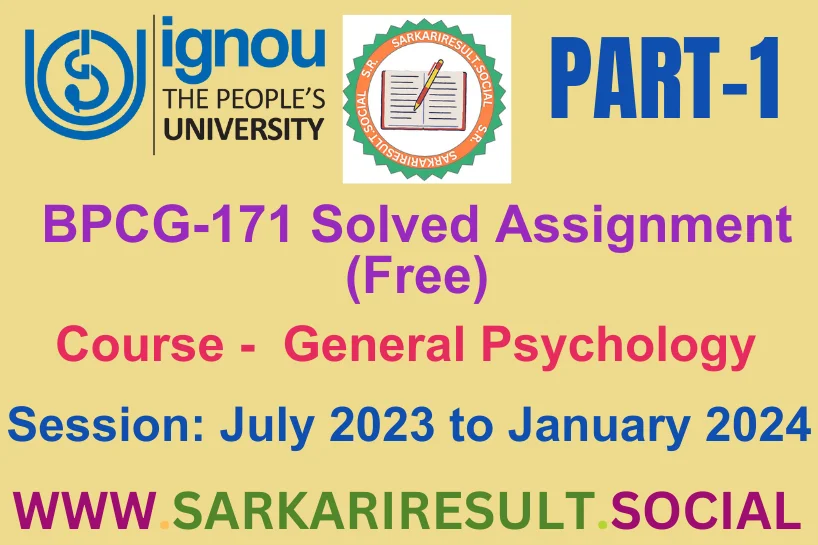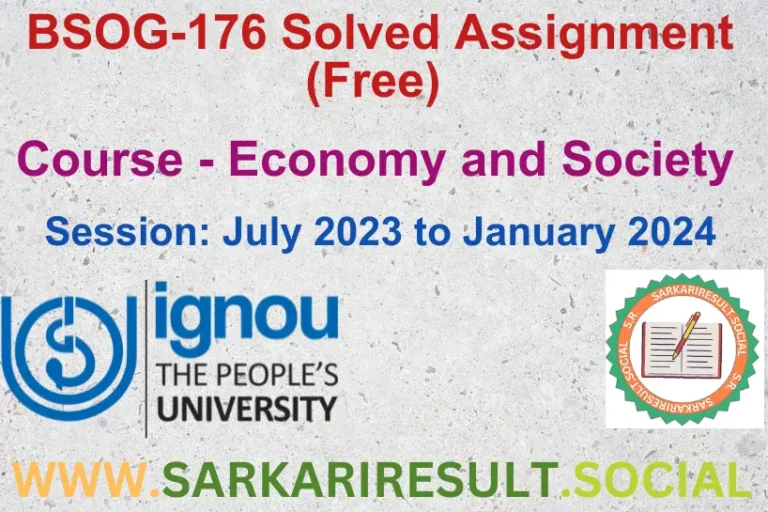BPCG 171 SOLVED IGNOU ASSIGNMENT FREE PART 1

Welcome to the BPCG 171 SOLVED IGNOU ASSIGNMENT FREE PART 1 TMA. Assignment – I presents two comprehensive questions. In about 500 words each, dive into the intricacies of neurons, nerve impulses, and the structure/functions of the nervous system. Shift gears to explore motivation by elaborating on its types and theories. Our IGNOU Solved Assignments 2024 for this section serve as your creative guide.

Answer the following in about 500 words each.
Q.1 Discuss the meaning, types of neurons and nerve impulse. Explain the structure and functions of nervous system.
Ans. The nervous system is a complex network of cells that transmit signals between different parts of the body. It is a critical component of the body’s communication system, allowing it to respond to internal and external stimuli. The nervous system can be broadly categorized into the central nervous system (CNS), which includes the brain and spinal cord, and the peripheral nervous system (PNS), which comprises nerves and ganglia outside the CNS.
Types of Neurons:
Neurons are the fundamental units of the nervous system, responsible for transmitting information. There are three main types of neurons:
1. Sensory Neurons:
– These neurons transmit signals from sensory receptors (e.g., in the skin, eyes, ears) to the central nervous system. They convey information about external and internal stimuli.
2. Motor Neurons:
– Motor neurons transmit signals from the central nervous system to muscles and glands, directing motor responses. They are involved in voluntary and involuntary movements.
3. Interneurons:
– Interneurons, or association neurons, operate within the central nervous system, connecting sensory and motor neurons. They play a crucial role in information processing and integration.
Nerve Impulse:
A nerve impulse is an electrochemical signal that travels along the membrane of a neuron. This process involves several key steps:
1. Resting State:
– Neurons maintain a resting membrane potential, with a slight negative charge inside relative to the outside. This state is maintained by the sodium-potassium pump.
2. Depolarization:
– When a stimulus reaches a neuron’s threshold, voltage-gated sodium channels open, allowing sodium ions to rush into the cell. This depolarizes the membrane, creating an action potential.
3. Action Potential:
– The sudden change in voltage triggers an action potential, a rapid and temporary reversal of the membrane potential. This electrical impulse travels along the neuron’s axon.
4. Repolarization:
– After depolarization, potassium channels open, allowing potassium ions to exit the cell. This repolarizes the membrane, restoring the negative charge.
5. Propagation:
– Action potentials propagate along the neuron’s axon, ensuring the signal travels the entire length of the neuron without losing strength.
6. Synaptic Transmission:
– At the axon terminals, action potentials trigger the release of neurotransmitters into the synapse. Neurotransmitters bind to receptors on the adjacent neuron, initiating a new action potential.
Structure and Functions of the Nervous System:
1. Central Nervous System (CNS):
– Structure: Comprises the brain and spinal cord, protected by the skull and vertebral column.
– Functions: Processes and integrates sensory information, initiates motor responses, and plays a crucial role in cognition, emotion, and consciousness.
2. Peripheral Nervous System (PNS):
– Structure: Consists of nerves and ganglia outside the CNS.
– Functions: Connects the CNS to the rest of the body. The PNS includes the somatic nervous system (voluntary movements) and autonomic nervous system (involuntary functions like heartbeat and digestion).
3. Somatic Nervous System:
– Structure: Controls voluntary movements through motor neurons.
– Functions: Enables conscious control over skeletal muscles, facilitating activities such as walking and writing.
4. Autonomic Nervous System:
– Structure: Regulates involuntary functions through sympathetic and parasympathetic divisions.
– Functions: Manages physiological processes like heart rate, digestion, and respiratory rate. Sympathetic activation prepares the body for “fight or flight,” while parasympathetic activity promotes “rest and digest.”
5. Brain:
– Structure: Divided into regions like the cerebrum, cerebellum, and brainstem.
– Functions: Responsible for higher cognitive functions, sensory processing, motor control, and regulation of vital functions.
6. Spinal Cord:
– Structure: Extends from the brainstem down the vertebral column.
– Functions: Facilitates communication between the brain and the peripheral nervous system. Also, acts as a reflex center, allowing rapid, involuntary responses to stimuli.
In summary, the nervous system is a sophisticated network that enables communication and coordination throughout the body. Neurons, nerve impulses, and the intricate structures of the CNS and PNS collectively contribute to the essential functions of the nervous system, ensuring the body can adapt and respond to its internal and external environments.
Q.2 Elaborate upon the different types and theories of motivation.
Ans. Motivation is a complex psychological concept that drives behavior and influences goal-directed activities. Various types and theories of motivation offer insights into understanding why individuals initiate and sustain certain behaviors. Here, we explore different types and key motivational theories:
1. Intrinsic Motivation:
– Definition: Intrinsic motivation stems from internal factors, such as personal enjoyment, curiosity, or a sense of accomplishment. Individuals engage in activities because they find them inherently rewarding.
– Example: A person playing a musical instrument for the sheer joy of creating music.
2. Extrinsic Motivation:
– Definition: Extrinsic motivation arises from external factors like rewards, punishments, or recognition. Individuals engage in activities to attain external outcomes or avoid negative consequences.
– Example: Studying for good grades or working to earn a salary.
3. Biological Motivation:
– Definition: Biological factors, such as hunger, thirst, and sleep, drive behavior to satisfy basic physiological needs.
– Example: Eating when hungry or sleeping when fatigued.
4. Achievement Motivation:
– Definition: Achievement motivation focuses on the desire to excel, surpass standards, and accomplish challenging goals.
– Example: Striving for high academic grades or setting ambitious career targets.
5. Social Motivation:
– Definition: Social motivation is driven by the need for social interaction, approval, or affiliation.
– Example: Participating in group activities, seeking friendships, or working collaboratively in a team.
6. Cognitive Motivation:
– Definition: Cognitive motivation is based on mental processes like curiosity, learning, and the desire for knowledge.
– Example: Engaging in problem-solving activities, pursuing education, or exploring new ideas.
7. Drive Reduction Theory:
– Definition: Proposed by Clark Hull, this theory suggests that physiological needs create internal tensions or drives, leading individuals to engage in behaviors that reduce these tensions and restore homeostasis.
– Example: Drinking water to reduce the drive of thirst.
8. Maslow’s Hierarchy of Needs:
– Definition: Abraham Maslow’s hierarchy posits that human needs are arranged in a pyramid, starting with basic physiological needs and progressing through safety, love and belonging, esteem, and culminating in self-actualization.
– Example: Fulfilling basic needs like food and shelter before seeking personal growth and self-realization.
9. Expectancy-Value Theory:
– Definition: Developed by Vroom, this theory suggests that an individual’s motivation to engage in a behavior is determined by the expectancy of achieving a desired outcome and the value placed on that outcome.
– Example: Choosing a challenging task because one expects success and values the rewards associated with it.
10. Self-Determination Theory (SDT):
– Definition: SDT proposes that individuals are motivated when their actions align with three innate psychological needs: autonomy (control over one’s actions), competence (mastery of tasks), and relatedness (social connections).
– Example: Choosing a career that allows for personal growth and aligns with one’s values.
11. Goal-Setting Theory:
– Definition: This theory posits that setting specific, challenging goals enhances motivation and performance. Feedback and commitment contribute to goal achievement.
– Example: Deciding to achieve a specific sales target within a given timeframe.
12. Herzberg’s Two-Factor Theory:
– Definition: Herzberg proposed that job satisfaction and dissatisfaction are influenced by separate factors. Hygiene factors (e.g., salary, work conditions) prevent dissatisfaction, while motivators (e.g., achievement, recognition) lead to job satisfaction.
– Example: Adequate salary prevents dissatisfaction, while recognition motivates job satisfaction.
Understanding the diverse types and theories of motivation provides valuable insights for individuals, educators, and organizations seeking to enhance performance, satisfaction, and well-being. Different contexts may require the application of specific motivational approaches to effectively address the unique needs and goals of individuals or groups.
Also See This: BPCG 171 SOLVED IGNOU ASSIGNMENT FREE PART 2







